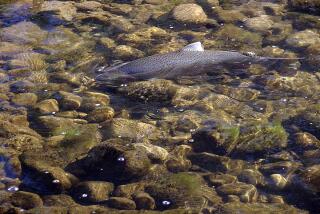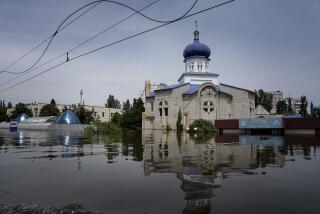Plan to save the Dead Sea is stirring to life
GHOR HADITHA, JORDAN — Jordan, Israel and the Palestinians are slowly pushing through the tangle of their disputes and suspicions in a race to save a biblical and ecological treasure, the Dead Sea.
The famously salty sea, which lies at Earth’s lowest point on land, is shrinking. It has receded by about 3 feet a year for the last 25 years, and Jordan and Israel warn that if the trend continues, it will vanish by 2050 along with its unique ecosystem, defeated by river diversions, mineral extraction and natural causes, such as evaporation.
A crucial project to boost the water level by piping in water from the Red Sea has long been held up by disputes between Israel and its Palestinian and Jordanian neighbors.
“But the ball began to roll a few months ago because of the gravity of the situation and the dangers facing the Dead Sea, which is a unique heritage not only to the countries that border it but to the whole world,” said Mohammed Zafer Alem, Jordan’s minister of water and irrigation.
The urgency is made clear by a dramatic side effect of the dwindling water: sinkholes.
These yawn open in a flash, leaving pits 100 feet deep or more in the sponge-like terrain. At Ghor Haditha, a Jordanian village of 6,000 people on the Dead Sea’s southern tip, signs warn of the peril and huge holes dot the vegetable fields.
The sinkholes happen because underground aquifers shrink and salt left by the receding Dead Sea waters erodes the earth.
The Dead Sea, or Salt Sea, is mentioned in the Old Testament. The sinful cities of Sodom and Gomorrah are said to have stood on its banks, and from nearby Mount Nebo, Moses reputedly first saw the Promised Land.
The placid, sun-baked lake, surrounded by spectacular desert cliffs, also has become a tourist attraction for Jordan and Israel, due to a belief in the curative powers of its waters and black mud. Five-star hotels are sprouting on its shores, creating pollution problems that pose a further threat.
The Dead Sea lies nearly 1,400 feet below sea level. It is 42 miles long, up to 11 miles wide and more than 1,000 feet deep. With salinity of about 30% -- more than eight times that of oceans, it is considered the world’s saltiest body of water. It is bounded by Jordan on the east and Israel and the West Bank on the west.
The Jordan River that flows into the Dead Sea is part of a river network whose overuse and diversions by Jordan, Israel and Syria compound the shrinkage.
After Jordan and Israel signed a peace treaty in 1994, they began considering ideas to save the Dead Sea. One plan, to draw water from the Mediterranean, about 50 miles to the west, was shelved as too costly, so “Med-Dead” shifted to “Red-Dead” -- an underground pipeline bringing water from the Red Sea, 125 miles south.
But the collapse of Israeli-Palestinian peace negotiations and subsequent violence put the brakes on the project.
The sides agreed in late 2005 to launch a feasibility study for the pipeline, but Israel balked after the landslide January 2006 election victory of the militant Hamas group and its eventual takeover of the Palestinian government in the West Bank and Gaza Strip.
With renewed Jordanian prodding to resurrect the project, a compromise was reached to include Palestinian moderates on a committee overseeing it.
The feasibility study finally began this year, with 60% of its $15.5-million cost provided by the United States and other Western donors. The pipeline itself will cost $1 billion and take two years to complete, if funding can be found.
There also are plans for a $1.5-billion plant to desalinate Red Sea water for use by Jordan, Israel and the Palestinians.
“The Red-Dead project is very significant to Israel because the surrounding area is water-poor, and in 10 or 15 years there will be no water there,” except whatever is piped in for drinking, said Israeli Foreign Ministry official Jacob Keidar, speaking on the phone from Jerusalem about groundwater wells in the nearby Jordan Valley area.
Alem, the Jordanian water minister, said the shrinkage was “more catastrophic” than that of the Aral Sea in Central Asia.
Once the world’s fourth-largest inland water body, the Aral, which lies between Uzbekistan and Kazakhstan, has lost three-quarters of its surface area in less than half a century because of Soviet-era diversion of rivers to promote farming.
“The Dead Sea is a worse disaster than the Aral because it’s shrinking quicker and the catastrophe it poses is greater to the surrounding ecosystem, the economy from its minerals and the site as a world cultural and religious heritage,” Alem said.
More to Read
Sign up for Essential California
The most important California stories and recommendations in your inbox every morning.
You may occasionally receive promotional content from the Los Angeles Times.










